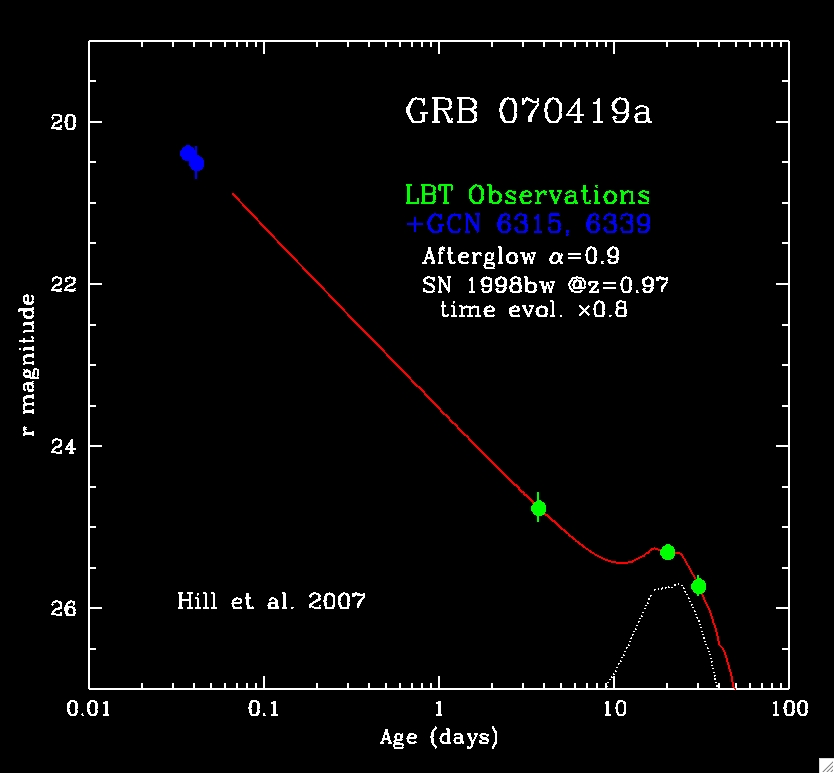(All information courtesy of the instrument teams.)
![]() Previous IAU Circulars
Previous IAU Circulars
TITLE: GCN/SWIFT NOTICE
NOTICE_DATE: Thu 19 Apr 07 10:00:41 UT
NOTICE_TYPE: Swift-BAT GRB Position
TRIGGER_NUM: 276205, Seg_Num: 0
GRB_RA: 182.714d {+12h 10m 51s} (J2000),
182.806d {+12h 11m 13s} (current),
182.083d {+12h 08m 20s} (1950)
GRB_DEC: +39.908d {+39d 54' 30"} (J2000),
+39.868d {+39d 52' 04"} (current),
+40.186d {+40d 11' 11"} (1950)
GRB_ERROR: 3.00 [arcmin radius, statistical only]
GRB_INTEN: 0 [cnts] Image_Peak=2494 [image_cnts]
TRIGGER_DUR: 64.000 [sec]
TRIGGER_INDEX: 20000 E_range: 15-50 keV
BKG_INTEN: 0 [cnts]
BKG_TIME: 0.00 SOD {00:00:00.00} UT
BKG_DUR: 0 [sec]
GRB_DATE: 14209 TJD; 109 DOY; 07/04/19
GRB_TIME: 35966.09 SOD {09:59:26.09} UT
GRB_PHI: 32.32 [deg]
GRB_THETA: 0.93 [deg]
SOLN_STATUS: 0x13
RATE_SIGNIF: 0.00 [sigma]
IMAGE_SIGNIF: 10.80 [sigma]
MERIT_PARAMS: +1 +0 +0 +6 +1 +0 +0 +0 +56 +1
SUN_POSTN: 26.93d {+01h 47m 44s} +11.11d {+11d 06' 36"}
SUN_DIST: 124.32 [deg] Sun_angle= -10.4 [hr] (East of Sun)
MOON_POSTN: 52.96d {+03h 31m 51s} +24.06d {+24d 03' 48"}
MOON_DIST: 100.82 [deg]
MOON_ILLUM: 6 [%]
GAL_COORDS: 153.73, 74.70 [deg] galactic lon,lat of the burst (or transient)
ECL_COORDS: 163.85, 37.09 [deg] ecliptic lon,lat of the burst (or transient)
COMMENTS: SWIFT-BAT GRB Coordinates.
COMMENTS: This is an image trigger. (The RATE_SIGNIF & BKG_{INTEN, TIME, DUR} are undefined.)
COMMENTS: A point_source was found.
COMMENTS: This does not match any source in the on-board catalog.
COMMENTS: This does not match any source in the ground catalog.
COMMENTS: This is a GRB.
COMMENTS: This trigger occurred at longitude,latitude = 215.01,-4.60 [deg].
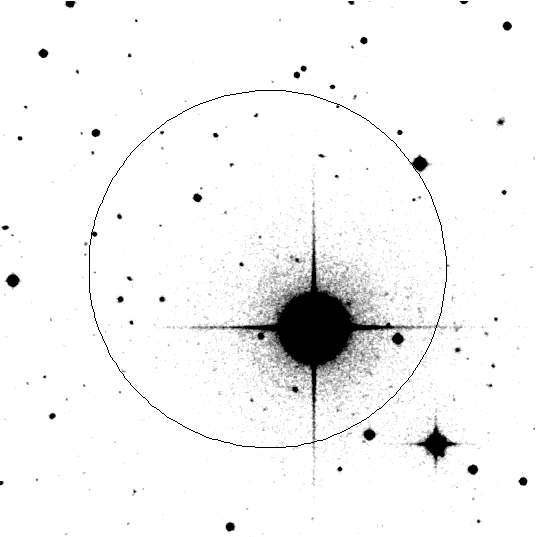
TITLE: GCN/SWIFT NOTICE
NOTICE_DATE: Thu 19 Apr 07 10:01:53 UT
NOTICE_TYPE: Swift-XRT Processed Image
TRIGGER_NUM: 276205, Seg_Num: 0
GRB_RA: 182.7459d {+12h 10m 59.0s} (J2000),
182.8377d {+12h 11m 21.0s} (current),
182.1153d {+12h 08m 27.6s} (1950)
GRB_DEC: +39.9248d {+39d 55' 29.2"} (J2000),
+39.8842d {+39d 53' 03.2"} (current),
+40.2030d {+40d 12' 10.6"} (1950)
GRB_ERROR: 4.7 [arcsec, radius, statistical plus systematic]
GRB_INTEN: 97 [cnts]
IMG_START_DATE: 14209 TJD; 109 DOY; 07/04/19
IMG_START_TIME: 36078.98 SOD {10:01:18.98} UT, 112.9 [sec] since BAT Trigger Time
CENTROID_X: 310.63, raw= 311 [pixels]
CENTROID_Y: 236.38, raw= 236 [pixels]
ROLL: 330.83 [deg]
GAIN: 2
MODE: 3, Long Image mode
WAVEFORM: 134
EXPO_TIME: 2.50 [sec]
GRB_POS_XRT_Y: -145.24
GRB_POS_XRT_Z: 19.65
IMAGE_URL: sw00276205000msxps_rw.img
SUN_POSTN: 26.94d {+01h 47m 45s} +11.11d {+11d 06' 37"}
SUN_DIST: 124.32 [deg] Sun_angle= -10.4 [hr] (East of Sun)
MOON_POSTN: 52.97d {+03h 31m 54s} +24.07d {+24d 04' 00"}
MOON_DIST: 100.81 [deg]
MOON_ILLUM: 6 [%]
GAL_COORDS: 153.62, 74.70 [deg] galactic lon,lat of the burst
ECL_COORDS: 163.87, 37.12 [deg] ecliptic lon,lat of the burst
COMMENTS: SWIFT-XRT Processed Image.

TITLE: GCN/SWIFT NOTICE
NOTICE_DATE: Thu 19 Apr 07 10:01:48 UT
NOTICE_TYPE: Swift-XRT Position
TRIGGER_NUM: 276205, Seg_Num: 0
GRB_RA: 182.7459d {+12h 10m 59.0s} (J2000),
182.8377d {+12h 11m 21.0s} (current),
182.1153d {+12h 08m 27.6s} (1950)
GRB_DEC: +39.9248d {+39d 55' 29.2"} (J2000),
+39.8842d {+39d 53' 03.2"} (current),
+40.2030d {+40d 12' 10.6"} (1950)
GRB_ERROR: 4.7 [arcsec radius, statistical plus systematic, 90% containment]
GRB_INTEN: 3.75e-09 [erg/cm2/sec]
GRB_SIGNIF: 9.84 [sigma]
IMG_START_DATE: 14209 TJD; 109 DOY; 07/04/19
IMG_START_TIME: 36078.98 SOD {10:01:18.98} UT, 112.9 [sec] since BAT Trigger Time
TAM[0-3]: 327.61 237.21 261.28 243.52
AMPLIFIER: 2
WAVEFORM: 134
SUN_POSTN: 26.94d {+01h 47m 44s} +11.11d {+11d 06' 37"}
SUN_DIST: 124.32 [deg] Sun_angle= -10.4 [hr] (East of Sun)
MOON_POSTN: 52.97d {+03h 31m 54s} +24.07d {+24d 03' 59"}
MOON_DIST: 100.81 [deg]
MOON_ILLUM: 6 [%]
GAL_COORDS: 153.62, 74.70 [deg] galactic lon,lat of the burst
ECL_COORDS: 163.87, 37.12 [deg] ecliptic lon,lat of the burst
COMMENTS: SWIFT-XRT Coordinates.
COMMENTS: The object found at this position is either a very bright burst or a cosmic ray hit.
COMMENTS: Examine the XRT Image to differentiate (CRs are much more compact; see examples at:
COMMENTS: http://www.swift.psu.edu/xrt/XRT_Postage_Stamp_Image_Photo_Gallery.htm .
TITLE: GCN/SWIFT NOTICE
NOTICE_DATE: Thu 19 Apr 07 10:01:48 UT
NOTICE_TYPE: Swift-XRT Image
TRIGGER_NUM: 276205, Seg_Num: 0
GRB_RA: 182.7459d {+12h 10m 59.0s} (J2000),
182.8377d {+12h 11m 21.0s} (current),
182.1153d {+12h 08m 27.6s} (1950)
GRB_DEC: +39.9248d {+39d 55' 29.2"} (J2000),
+39.8842d {+39d 53' 03.2"} (current),
+40.2030d {+40d 12' 10.6"} (1950)
GRB_ERROR: 4.7 [arcsec, radius, statistical plus systematic]
GRB_INTEN: 97 [cnts]
IMG_START_DATE: 14209 TJD; 109 DOY; 07/04/19
IMG_START_TIME: 36078.98 SOD {10:01:18.98} UT, 112.9 [sec] since BAT Trigger Time
CENTROID_X: 310.63, raw= 311 [pixels]
CENTROID_Y: 236.38, raw= 236 [pixels]
ROLL: 330.83 [deg]
GAIN: 2
MODE: 3, Long Image mode
WAVEFORM: 134
EXPO_TIME: 2.50 [sec]
GRB_POS_XRT_Y: -145.24
GRB_POS_XRT_Z: 19.65
IMAGE_URL: sw00276205000msxps_rw.img
SUN_POSTN: 26.94d {+01h 47m 44s} +11.11d {+11d 06' 37"}
SUN_DIST: 124.32 [deg] Sun_angle= -10.4 [hr] (East of Sun)
MOON_POSTN: 52.97d {+03h 31m 54s} +24.07d {+24d 03' 59"}
MOON_DIST: 100.81 [deg]
MOON_ILLUM: 6 [%]
GAL_COORDS: 153.62, 74.70 [deg] galactic lon,lat of the burst
ECL_COORDS: 163.87, 37.12 [deg] ecliptic lon,lat of the burst
COMMENTS: SWIFT-XRT Image.

TITLE: GCN/SWIFT NOTICE
NOTICE_DATE: Thu 19 Apr 07 10:03:22 UT
NOTICE_TYPE: Swift-BAT GRB Lightcurve
TRIGGER_NUM: 276205, Seg_Num: 0
GRB_RA: 182.714d {+12h 10m 51s} (J2000),
182.806d {+12h 11m 13s} (current),
182.083d {+12h 08m 20s} (1950)
GRB_DEC: +39.908d {+39d 54' 30"} (J2000),
+39.868d {+39d 52' 04"} (current),
+40.186d {+40d 11' 11"} (1950)
GRB_DATE: 14209 TJD; 109 DOY; 07/04/19
GRB_TIME: 35966.09 SOD {09:59:26.09} UT
TRIGGER_INDEX: 20000
GRB_PHI: 32.32 [deg]
GRB_THETA: 0.93 [deg]
DELTA_TIME: 0.00 [sec]
TRIGGER_DUR: 64.000 [sec]
SOLN_STATUS: 0x13
RATE_SIGNIF: 0.00 [sigma]
IMAGE_SIGNIF: 10.80 [sigma]
LC_URL: sw00276205000msb.lc
SUN_POSTN: 26.94d {+01h 47m 45s} +11.11d {+11d 06' 38"}
SUN_DIST: 124.32 [deg] Sun_angle= -10.4 [hr] (East of Sun)
MOON_POSTN: 52.99d {+03h 31m 58s} +24.07d {+24d 04' 15"}
MOON_DIST: 100.79 [deg]
MOON_ILLUM: 6 [%]
GAL_COORDS: 153.73, 74.70 [deg] galactic lon,lat of the burst (or transient)
ECL_COORDS: 163.85, 37.09 [deg] ecliptic lon,lat of the burst (or transient)
COMMENTS: SWIFT-BAT GRB Lightcurve.
COMMENTS:
COMMENTS: The next comments were copied from the BAT_POS Notice:
COMMENTS: This is an image trigger.
COMMENTS: A point_source was found.
COMMENTS: This does not match any source in the on-board catalog.
COMMENTS: This does not match any source in the ground catalog.
COMMENTS: This is a GRB.
COMMENTS: This trigger occurred at longitude,latitude = 215.01,-4.60 [deg].
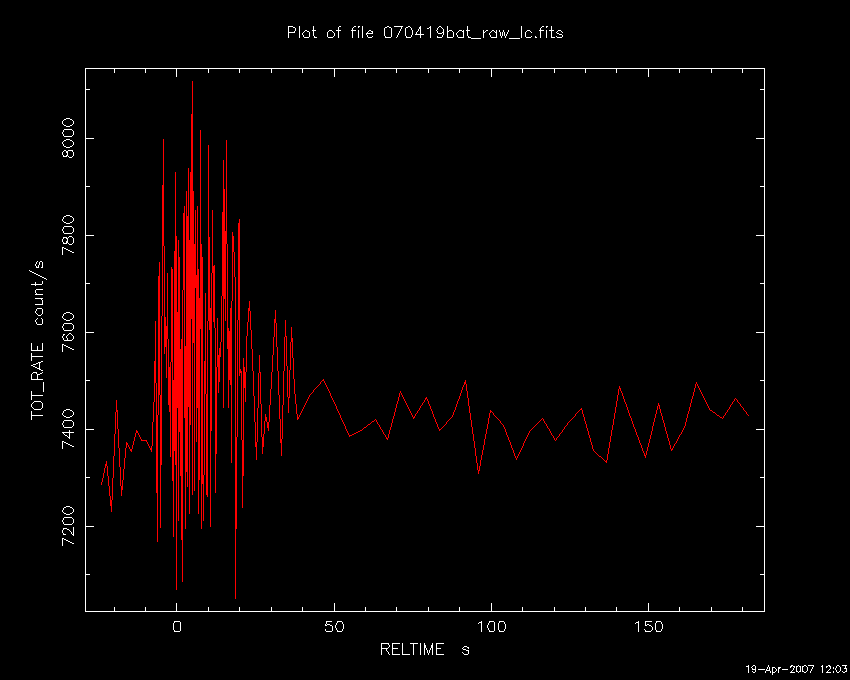
TITLE: GCN/SWIFT NOTICE
NOTICE_DATE: Thu 19 Apr 07 10:10:53 UT
NOTICE_TYPE: Swift-UVOT Source List
TRIGGER_NUM: 276205, Seg_Num: 0
POINT_RA: 182.697d {+12h 10m 47s} (J2000)
POINT_DEC: +39.910d {+39d 54' 36"} (J2000)
POINT_ROLL: 330.834d
IMG_START_DATE: 14209 TJD; 109 DOY; 07/04/19
IMG_START_TIME: 36081.49 SOD {10:01:21.49} UT, 115.4 [sec] since BAT Trigger Time
FILTER: 3, V
BKG_MEAN: 1.702
N_STARS: 190
X_OFFSET: 584 [pixels]
Y_OFFSET: 829 [pixels]
X_MAX: 1543 [pixels]
Y_MAX: 1788 [pixels]
DET_THRESH: 11
PHOTO_THRESH: 5
SL_URL: sw00276205000msufc0115.fits
SUN_POSTN: 26.94d {+01h 47m 46s} +11.11d {+11d 06' 45"}
SUN_DIST: 124.31 [deg] Sun_angle= -10.4 [hr] (East of Sun)
MOON_POSTN: 53.07d {+03h 32m 17s} +24.09d {+24d 05' 30"}
MOON_DIST: 100.72 [deg]
MOON_ILLUM: 6 [%]
GAL_COORDS: 153.77, 74.69 [deg] galactic lon,lat of the pointing direction
ECL_COORDS: 163.83, 37.08 [deg] ecliptic lon,lat of the pointing direction
COMMENTS: SWIFT-UVOT Source List.
TITLE: GCN/SWIFT NOTICE
NOTICE_DATE: Thu 19 Apr 07 10:11:25 UT
NOTICE_TYPE: Swift-UVOT Processed Source List
TRIGGER_NUM: 276205, Seg_Num: 0
POINT_RA: 182.697d {+12h 10m 47s} (J2000)
POINT_DEC: +39.910d {+39d 54' 36"} (J2000)
POINT_ROLL: 330.834d
IMG_START_DATE: 14209 TJD; 109 DOY; 07/04/19
IMG_START_TIME: 36081.49 SOD {10:01:21.49} UT, 115.4 [sec] since BAT Trigger Time
FILTER: 3, V
BKG_MEAN: 1.702
N_STARS: 190
X_OFFSET: 584 [pixels]
Y_OFFSET: 829 [pixels]
X_MAX: 1543 [pixels]
Y_MAX: 1788 [pixels]
DET_THRESH: 11
PHOTO_THRESH: 5
SL_URL: sw00276205000msufc0115.fits
SUN_POSTN: 26.94d {+01h 47m 46s} +11.11d {+11d 06' 45"}
SUN_DIST: 124.31 [deg] Sun_angle= -10.4 [hr] (East of Sun)
MOON_POSTN: 53.08d {+03h 32m 19s} +24.09d {+24d 05' 35"}
MOON_DIST: 100.72 [deg]
MOON_ILLUM: 6 [%]
GAL_COORDS: 153.77, 74.69 [deg] galactic lon,lat of the pointing direction
ECL_COORDS: 163.83, 37.08 [deg] ecliptic lon,lat of the pointing direction
COMMENTS: SWIFT-UVOT Processed Source List.
COMMENTS: All 4 attachments are included.
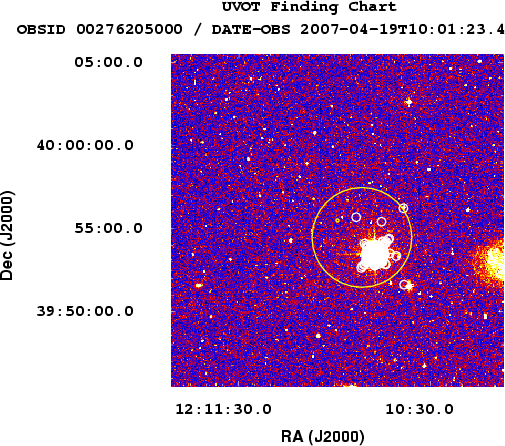
TITLE: GCN/SWIFT NOTICE
NOTICE_DATE: Thu 19 Apr 07 10:12:16 UT
NOTICE_TYPE: Swift-UVOT Image
TRIGGER_NUM: 276205, Seg_Num: 0
POINT_RA: 182.697d {+12h 10m 47s} (J2000)
POINT_DEC: +39.910d {+39d 54' 36"} (J2000)
ROLL: 330.834d
IMG_START_DATE: 14209 TJD; 109 DOY; 07/04/19
IMG_START_TIME: 36081.49 SOD {10:01:21.49} UT, 115.4 [sec] since BAT Trigger Time
FILTER: 3, V
EXPOSURE_ID: 198669683
X_OFFSET: 904 [pixels]
Y_OFFSET: 1149 [pixels]
WIDTH: 160 [pixels]
HEIGHT: 160 [pixels]
X_GRB_POS: 1064
Y_GRB_POS: 1309
BINNING_INDEX: 1
IM_URL: sw00276205000msuni0115.fits
SUN_POSTN: 26.94d {+01h 47m 46s} +11.11d {+11d 06' 46"}
SUN_DIST: 124.31 [deg] Sun_angle= -10.4 [hr] (East of Sun)
MOON_POSTN: 53.09d {+03h 32m 21s} +24.10d {+24d 05' 44"}
MOON_DIST: 100.71 [deg]
MOON_ILLUM: 6 [%]
GAL_COORDS: 153.77, 74.69 [deg] galactic lon,lat of the pointing direction
ECL_COORDS: 163.83, 37.08 [deg] ecliptic lon,lat of the pointing direction
COMMENTS: SWIFT-UVOT Image.
COMMENTS: The GRB Position came from the XRT Position Command.
COMMENTS: The image has 2x2 binning (compression).
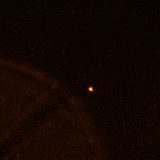
TITLE: GCN/SWIFT NOTICE
NOTICE_DATE: Thu 19 Apr 07 10:12:33 UT
NOTICE_TYPE: Swift-UVOT Processed Image
TRIGGER_NUM: 276205, Seg_Num: 0
POINT_RA: 182.697d {+12h 10m 47s} (J2000)
POINT_DEC: +39.910d {+39d 54' 36"} (J2000)
ROLL: 330.834d
IMG_START_DATE: 14209 TJD; 109 DOY; 07/04/19
IMG_START_TIME: 36081.49 SOD {10:01:21.49} UT, 115.4 [sec] since BAT Trigger Time
FILTER: 3, V
EXPOSURE_ID: 198669683
X_OFFSET: 904 [pixels]
Y_OFFSET: 1149 [pixels]
WIDTH: 160 [pixels]
HEIGHT: 160 [pixels]
X_GRB_POS: 1064
Y_GRB_POS: 1309
BINNING_INDEX: 1
IM_URL: sw00276205000msuni0115.fits
SUN_POSTN: 26.94d {+01h 47m 46s} +11.11d {+11d 06' 46"}
SUN_DIST: 124.31 [deg] Sun_angle= -10.4 [hr] (East of Sun)
MOON_POSTN: 53.09d {+03h 32m 22s} +24.10d {+24d 05' 47"}
MOON_DIST: 100.71 [deg]
MOON_ILLUM: 6 [%]
GAL_COORDS: 153.77, 74.69 [deg] galactic lon,lat of the pointing direction
ECL_COORDS: 163.83, 37.08 [deg] ecliptic lon,lat of the pointing direction
COMMENTS: SWIFT-UVOT Processed Image.
COMMENTS: The GRB Position came from the XRT Position Command.
COMMENTS: The image has 2x2 binning (compression).
COMMENTS: All 4 attachments are included.
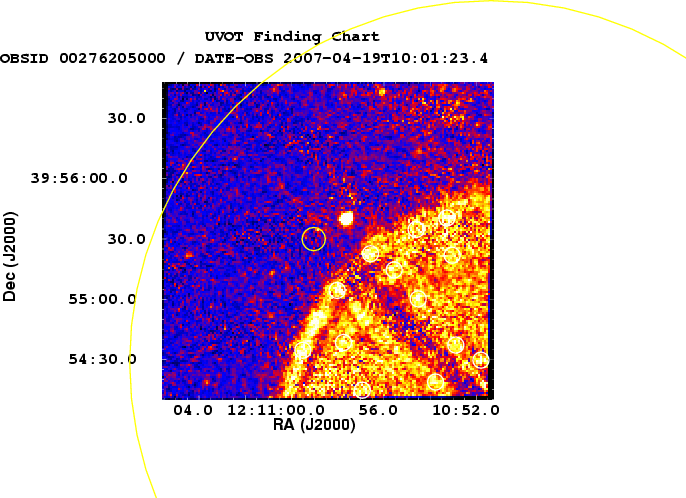
TITLE: GCN/SWIFT NOTICE
NOTICE_DATE: Thu 19 Apr 07 10:19:56 UT
NOTICE_TYPE: Swift-UVOT Source List
TRIGGER_NUM: 276205, Seg_Num: 0
POINT_RA: 182.696d {+12h 10m 47s} (J2000)
POINT_DEC: +39.910d {+39d 54' 35"} (J2000)
POINT_ROLL: 330.836d
IMG_START_DATE: 14209 TJD; 109 DOY; 07/04/19
IMG_START_TIME: 36834.62 SOD {10:13:54.62} UT, 868.5 [sec] since BAT Trigger Time
FILTER: 3, V
BKG_MEAN: 1.507
N_STARS: 190
X_OFFSET: 584 [pixels]
Y_OFFSET: 829 [pixels]
X_MAX: 1543 [pixels]
Y_MAX: 1788 [pixels]
DET_THRESH: 10
PHOTO_THRESH: 5
SL_URL: sw00276205000msufc0868.fits
SUN_POSTN: 26.95d {+01h 47m 47s} +11.11d {+11d 06' 53"}
SUN_DIST: 124.30 [deg] Sun_angle= -10.4 [hr] (East of Sun)
MOON_POSTN: 53.17d {+03h 32m 41s} +24.12d {+24d 07' 00"}
MOON_DIST: 100.65 [deg]
MOON_ILLUM: 6 [%]
GAL_COORDS: 153.77, 74.69 [deg] galactic lon,lat of the pointing direction
ECL_COORDS: 163.83, 37.08 [deg] ecliptic lon,lat of the pointing direction
COMMENTS: SWIFT-UVOT Source List.
TITLE: GCN/SWIFT NOTICE
NOTICE_DATE: Thu 19 Apr 07 10:20:26 UT
NOTICE_TYPE: Swift-UVOT Processed Source List
TRIGGER_NUM: 276205, Seg_Num: 0
POINT_RA: 182.696d {+12h 10m 47s} (J2000)
POINT_DEC: +39.910d {+39d 54' 35"} (J2000)
POINT_ROLL: 330.836d
IMG_START_DATE: 14209 TJD; 109 DOY; 07/04/19
IMG_START_TIME: 36834.62 SOD {10:13:54.62} UT, 868.5 [sec] since BAT Trigger Time
FILTER: 3, V
BKG_MEAN: 1.507
N_STARS: 190
X_OFFSET: 584 [pixels]
Y_OFFSET: 829 [pixels]
X_MAX: 1543 [pixels]
Y_MAX: 1788 [pixels]
DET_THRESH: 10
PHOTO_THRESH: 5
SL_URL: sw00276205000msufc0868.fits
SUN_POSTN: 26.95d {+01h 47m 47s} +11.11d {+11d 06' 53"}
SUN_DIST: 124.30 [deg] Sun_angle= -10.4 [hr] (East of Sun)
MOON_POSTN: 53.18d {+03h 32m 42s} +24.12d {+24d 07' 05"}
MOON_DIST: 100.64 [deg]
MOON_ILLUM: 6 [%]
GAL_COORDS: 153.77, 74.69 [deg] galactic lon,lat of the pointing direction
ECL_COORDS: 163.83, 37.08 [deg] ecliptic lon,lat of the pointing direction
COMMENTS: SWIFT-UVOT Processed Source List.
COMMENTS: All 4 attachments are included.
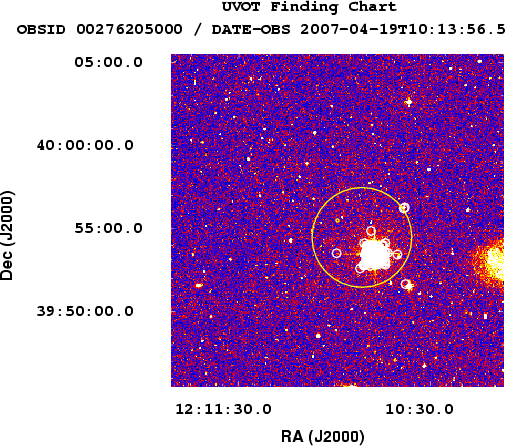
TITLE: GCN/SWIFT NOTICE
NOTICE_DATE: Thu 19 Apr 07 10:21:13 UT
NOTICE_TYPE: Swift-UVOT Image
TRIGGER_NUM: 276205, Seg_Num: 0
POINT_RA: 182.696d {+12h 10m 47s} (J2000)
POINT_DEC: +39.910d {+39d 54' 35"} (J2000)
ROLL: 330.836d
IMG_START_DATE: 14209 TJD; 109 DOY; 07/04/19
IMG_START_TIME: 36834.62 SOD {10:13:54.62} UT, 868.5 [sec] since BAT Trigger Time
FILTER: 3, V
EXPOSURE_ID: 198670436
X_OFFSET: 903 [pixels]
Y_OFFSET: 1148 [pixels]
WIDTH: 160 [pixels]
HEIGHT: 160 [pixels]
X_GRB_POS: 1063
Y_GRB_POS: 1308
BINNING_INDEX: 1
IM_URL: sw00276205000msuni0868.fits
SUN_POSTN: 26.95d {+01h 47m 48s} +11.11d {+11d 06' 54"}
SUN_DIST: 124.30 [deg] Sun_angle= -10.4 [hr] (East of Sun)
MOON_POSTN: 53.19d {+03h 32m 44s} +24.12d {+24d 07' 13"}
MOON_DIST: 100.64 [deg]
MOON_ILLUM: 6 [%]
GAL_COORDS: 153.77, 74.69 [deg] galactic lon,lat of the pointing direction
ECL_COORDS: 163.83, 37.08 [deg] ecliptic lon,lat of the pointing direction
COMMENTS: SWIFT-UVOT Image.
COMMENTS: The GRB Position came from the Window Position in the Mode Command.
COMMENTS: The image has 2x2 binning (compression).
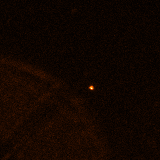
TITLE: GCN/SWIFT NOTICE
NOTICE_DATE: Thu 19 Apr 07 10:21:32 UT
NOTICE_TYPE: Swift-UVOT Processed Image
TRIGGER_NUM: 276205, Seg_Num: 0
POINT_RA: 182.696d {+12h 10m 47s} (J2000)
POINT_DEC: +39.910d {+39d 54' 35"} (J2000)
ROLL: 330.836d
IMG_START_DATE: 14209 TJD; 109 DOY; 07/04/19
IMG_START_TIME: 36834.62 SOD {10:13:54.62} UT, 868.5 [sec] since BAT Trigger Time
FILTER: 3, V
EXPOSURE_ID: 198670436
X_OFFSET: 903 [pixels]
Y_OFFSET: 1148 [pixels]
WIDTH: 160 [pixels]
HEIGHT: 160 [pixels]
X_GRB_POS: 1063
Y_GRB_POS: 1308
BINNING_INDEX: 1
IM_URL: sw00276205000msuni0868.fits
SUN_POSTN: 26.95d {+01h 47m 48s} +11.12d {+11d 06' 54"}
SUN_DIST: 124.30 [deg] Sun_angle= -10.4 [hr] (East of Sun)
MOON_POSTN: 53.19d {+03h 32m 45s} +24.12d {+24d 07' 16"}
MOON_DIST: 100.63 [deg]
MOON_ILLUM: 6 [%]
GAL_COORDS: 153.77, 74.69 [deg] galactic lon,lat of the pointing direction
ECL_COORDS: 163.83, 37.08 [deg] ecliptic lon,lat of the pointing direction
COMMENTS: SWIFT-UVOT Processed Image.
COMMENTS: The GRB Position came from the Window Position in the Mode Command.
COMMENTS: The image has 2x2 binning (compression).
COMMENTS: All 4 attachments are included.
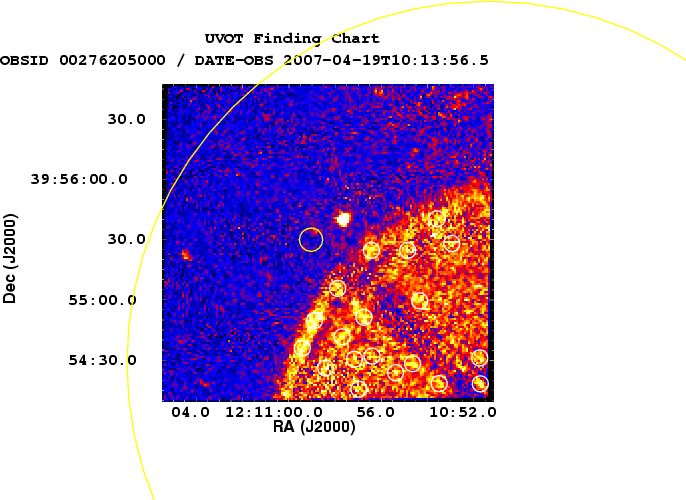
RA(J2000) = 12h 10m 51s Dec(J2000) = +39d 54' 30"with an uncertainty of 3 arcmin (radius, 90% containment, including systematic uncertainty). The BAT light curve suggests emission from T-10 to T+20 with a peak count rate of ~500 counts/sec (15-350 keV), at ~4 sec after the trigger. However, as for most image triggers, the TDRSS light curve data is noisy and we will require the Malindi pass data for a more definitive analysis.
RA(J2000) = 12h 10m 59.1s Dec(J2000) =39d 55' 28.2"with an uncertainty of 7.0 arcseconds (radius, 90% containment). The given uncertainty takes into account the presence of a nearby CCD bad column. This location is 110 arcseconds from the BAT on-board position, within the BAT error circle. The initial flux in the 2.5s image was 3.7e-09 erg/cm2/s (0.2-10 keV).
start UT end UT t_exp(s) mlim t_start-tGRB(s) Coadd? -------------------------------------------------------------------- 10:00:47.3 10:00:52.3 5 16.0 81.2 N 10:00:47.3 10:01:54.4 67 17.8 81.2 Y
Mean Date Time Since Burst Magnitude -------------------------------------------------------------------------- 10:05:18 5.87 min 19.7 10:10:31 11.08 min 18.7The above magnitudes were calculated assuming a magnitude of R=15.22 for the the USNO-B reference star located at 12:10:57.57, +39:55:40.2.
T filter magn error(magn)
(hours post trigger)
--------------------------------------------------
0.654 J 18.27 0.08
0.734 H 17.83 0.13
0.814 J 18.56 0.09
0.896 K 17.26 0.18
1.665 K 18.30 0.18
The magnitudes are calibrated with respect to the 2MASS catalogue.
-------------------------------------------------------------- Start(UT) End(UT) Num. of frames Limit (mag.) -------------------------------------------------------------- 10:42:40 10:43:10 1 ~16.2 10:42:40 10:53:36 10 ~17.7 ---------------------------------------------------------------
UTC minutes_since_trigger Mag 10:49:46.5 50.36 g' > 19.8 (limit only) 10:51:20.8 51.91 r' = 20.37 10:53:07.9 53.70 i' = 20.22Magnitudes are based on comparison with SDSS magnitudes of the adjacent star SDSS J121057.55+395539.9.
RA(J2000) = 12h 11m 1.1s Dec(J2000) = 39d 54' 11.0"with an uncertainty of 2.3 arcmin, (radius, sys+stat, 90% containment). The coding fraction was 1.
t_start (UT) exp t_tot (s) Nsum t_start-t_0 (s) R Mag ---------------------------------------------------------------- 10:01:08.1 10 1 102 R > 17.71 10:01:08.1 50 5 102 R > 18.58 10:02:33.1 20 1 187 R > 18.24 10:02:33.1 100 5 187 R > 19.19 10:04:47.9 60 1 322 R > 18.60 10:07:01.8 60 1 456 R = 18.49 +/- 0.22Additional observations followed our initial set and analysis are ongoing.
--------------------------------------------------------------- band mid-UT exp.time brightness g' Apr. 19 12:00 106 x 1 min. 20.9 +- 0.2 mag Rc Apr. 19 12:00 106 x 1 min. > 21.5 mag (upper limit) Ic Apr. 19 12:00 106 x 1 min. > 19.4 mag (upper limit) ---------------------------------------------------------------
RA(J2000) = 12h 10m 58.80s Dec(J2000) = +39d 55' 32.4"with an uncertainty of 2.2" (90% containment). This is 1.4' away from the centre of the refined BAT position (Stamatikos et al. GCN Circ. 6326), 5.4" away from the initial XRT position (Stamatikos et al., GCN Circ. 6302) and 1.5" away from the optical position (Chornock et al., GCN Circ. 6304).
Filter Start(s) End(s) Exposure(s) Magnitude ----------------------------------------------------------------- V 115 515 394 20.2 =B1 0.3 V 869 1204 330 20.0 =B1 0.3 B 594 739 19 >18.7 U 569 861 58 >19.1The magnitudes are not corrected for the Galactic reddening of E(B-V)=0= .03
UT Time delta Time R magnitude error 10:26:37 60.0 s 19.12 0.09The V-band magnitude of the afterglow in the first V-band image is:
UT Time delta Time V magnitude error 10:35:35 60.0 s 19.66 0.14This message can be cited.
The LBT is an international collaboration among institutions in the United States, Italy and Germany. The LBT Corporation partners are: * The University of Arizona on behalf of the Arizona university system * Istituto Nazionale di Astrofisica, Italy * LBT Beteiligungsgesellschaft, Germany, representing the Max Planck Society, the Astrophysical Institute Potsdam, and Heidelberg University * The Ohio State University * The Research Corporation, on behalf of The University of Notre Dame, University of Minnesota and University of VirginiaThis message may be cited
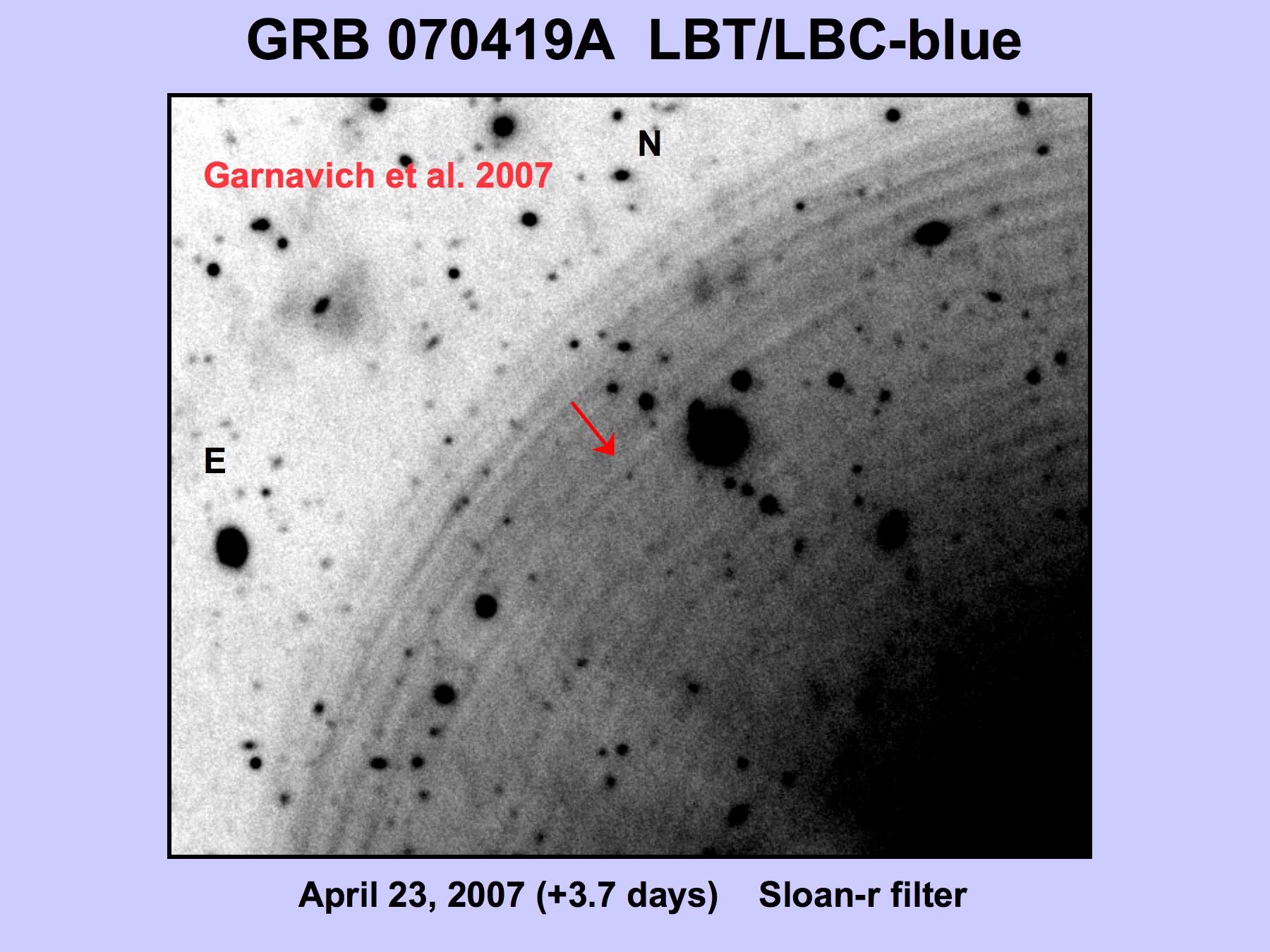
T0+ , Exposure, R_mag 0.245 d 11x300 s 22.4 +/- 0.3Our observation is compatible with global power law decay index 0.9 (Garnavich et al. GCN 6406) suggesting no host galaxy contribution in epoch of our observation.
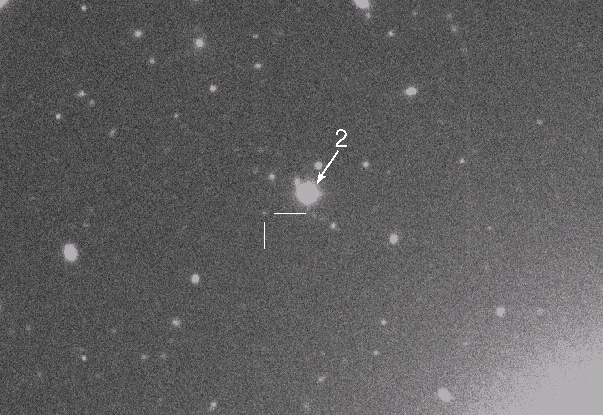
UT Date Age (days) Exposures Seeing r mag Error ----------------------------------------------------------- Apr 23.15 3.7 10x200s 1.2" 24.75 0.18 (GCN 6406) May 10.18 20.8 25x200s 0.96" 25.29 0.05 May 20.22 30.8 15x200s 0.73" 25.71 0.13The decay between 4 days (LBT observation from GCN 6406) and 20 days after the burst is very slow and corresponds to a power-law index of 0.3. This could indicate host galaxy contamination, but the images remain unresolved. Extrapolating the decline to 30 days post-burst predicts the afterglow should be 30% brighter than the actual observed magnitude. This increased fading rate is inconsistent with a host galaxy dominating the flux and suggests light from a GRB progenitor supernova may be powering the late-time light curve.
The LBT is an international collaboration among institutions in the United States, Italy and Germany. The LBT Corporation partners are: * The University of Arizona on behalf of the Arizona university system * Istituto Nazionale di Astrofisica, Italy * LBT Beteiligungsgesellschaft, Germany, representing the Max Planck Society, the Astrophysical Institute Potsdam, and Heidelberg University * The Ohio State University * The Research Corporation, on behalf of The University of Notre Dame, University of Minnesota and University of VirginiaThis message may be cited
